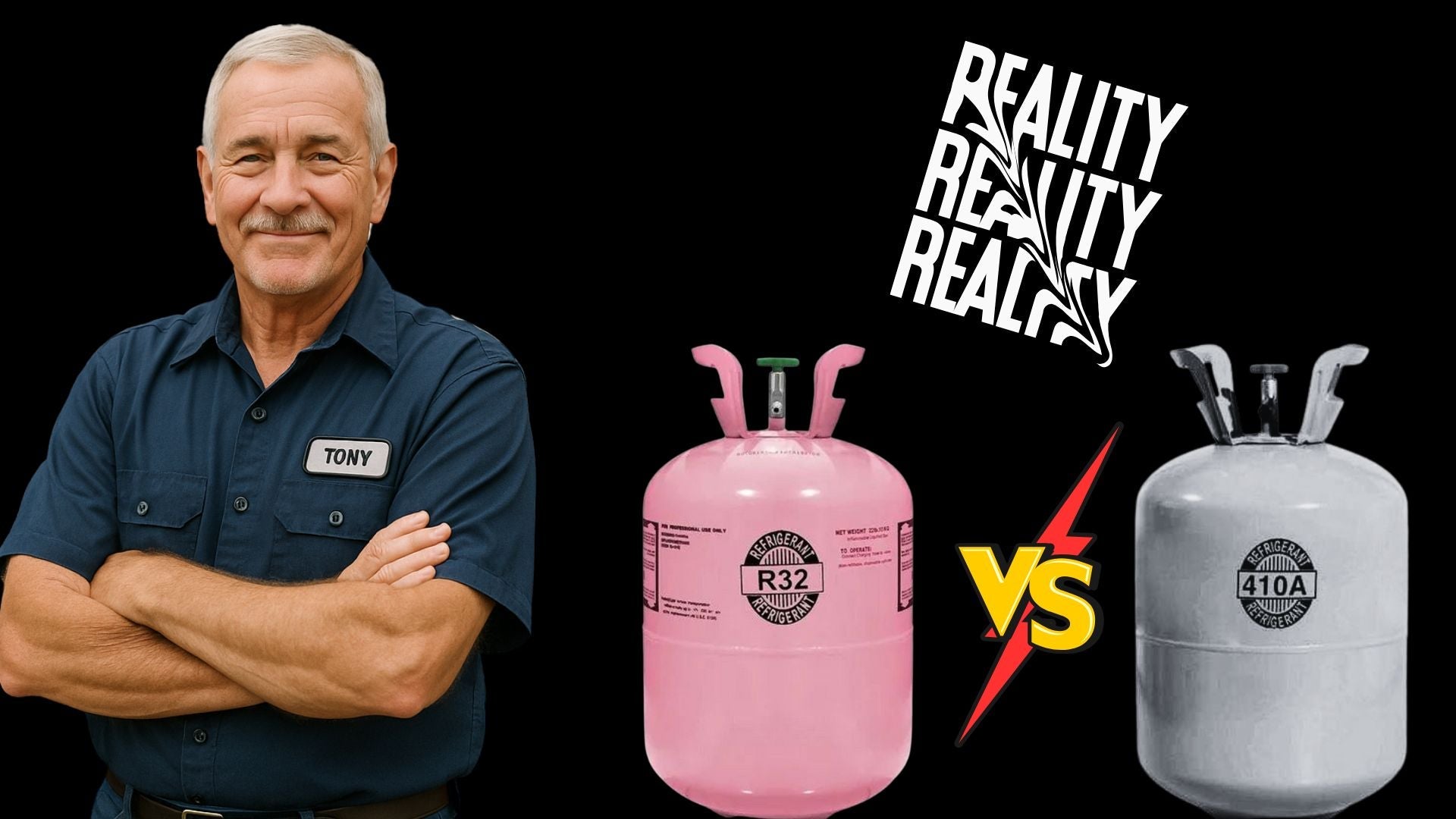(By Tony the Trusted Tech)
Let’s cut through the fluff.
You’ve probably heard R-32 is replacing R-410A. But if you're like me, you’re not just buying into the hype. You want real-world, boots-on-the-roof feedback.
I’ve worked with both refrigerants in the field — during installs, service calls, and clean-ups after a rough install job. Here’s what actually matters when it comes to performance, safety, cost, and long-term viability.
Why R-410A Is Being Phased Out
R-410A has been the workhorse for residential HVAC since it replaced R-22. It’s efficient, reliable, and widely supported.
But the problem? It’s a high Global Warming Potential (GWP) refrigerant. The EPA's AIM Act is phasing out high-GWP refrigerants as part of the HFC phasedown schedule to slow climate change.
R-410A has a GWP of 2088. Compare that to R-32, which clocks in at 675, and you see why manufacturers are shifting fast.
The Basics: R-32 vs. R-410A
| Feature | R-32 | R-410A |
|---|---|---|
| GWP | 675 | 2088 |
| Pressure | Slightly higher | Standard (reference) |
| Efficiency | Higher heat transfer | Good |
| Flammability | Mildly flammable (A2L) | Non-flammable (A1) |
| Charge amount | ~20-30% less needed | Higher charge volume |
| Environmental Impact | Lower | Higher |
You can find a deeper technical breakdown from the ASHRAE position document on refrigerants.
Installation: What Techs Need to Know
Good news?
If you’ve worked with R-410A, R-32 isn’t a massive leap. But there are some must-knows:
1. R-32 Uses Standard R-410A Equipment
Same copper, same tools, same service valves — no need to retool your whole truck.
Just double-check compatibility on recovery units and leak detectors. Some older models don’t support A2L classification.
Check Fieldpiece’s A2L-compatible tools if you're upgrading.
2. Flammability = Respect the Safety Protocols
Yes, R-32 is mildly flammable, but it’s not like you're dealing with propane.
It's labeled A2L, meaning:
-
Low toxicity
-
Low flammability
-
Needs a spark + right concentration to ignite
Translation? Use common sense:
-
Ventilate the space
-
Don’t braze near charged lines
-
No open flames during recovery or charging
Read AHRI's A2L safety guidance for specifics if you're just getting into it.
Performance in the Field
1. Better Efficiency, Lower Charges
With a higher volumetric cooling capacity and lower charge requirement, R-32 systems like the Goodman 3 Ton 14.5 SEER2 unit tend to:
-
Cool faster
-
Hit setpoints quicker
-
Require 20–30% less refrigerant
That means smaller tanks, less cost per install, and quicker pulls to vacuum.
2. Lower Head Pressure in Heat
I’ve seen R-32 systems handle hot attic installs better. The system doesn’t ramp up head pressure as quickly, which reduces compressor stress — a huge win if you're doing installs in hot southern states.
Serviceability: Easier or Harder?
Honestly? Not much different than R-410A. Just remember:
-
You can’t mix R-410A and R-32
-
You need a dedicated recovery tank
-
Follow your leak detection best practices
One big plus?
R-32 is a single-component refrigerant, not a blend like R-410A. That means:
-
No glide
-
No fractionation
-
Easier top-offs (though full recharge is still preferred)
Check HVAC School’s tech guide to R-32 refrigerants for a service-specific rundown.
Safety Myths: Busted
There’s a lot of fear-mongering online about flammability.
Let me be clear: R-32 is not a danger when installed and serviced properly. Residential units have:
-
Smaller charge volumes
-
Closed-loop systems
-
Built-in safeguards like pressure switches and flame arrestors
Most AHRI-certified systems go through rigorous UL 60335-2-40 safety testing before they ever hit the market.
What This Means for You (Homeowners + Contractors)
If you're a homeowner, R-32 is a solid upgrade. It offers:
-
Lower environmental impact
-
Higher energy efficiency
-
A path forward that’s regulation-proof for the next 10+ years
If you’re a contractor, now’s the time to:
-
Brush up on A2L best practices
-
Start stocking R-32 recovery tanks and compatible tools
-
Educate your customers on the transition
Final Verdict: R-32 Is the Future (And It's Already Here)
I’ll say it plain:
R-32 is not experimental — it’s the standard in over 100 million systems worldwide.
The Goodman 3 Ton 14.5 SEER2 system is part of that next generation of units that gives you high performance without locking you into a dying refrigerant.
So yeah, I’m a fan.
Is it different? Sure.
Is it better in the field? In most cases — yes.
Is it something to be afraid of? Not if you do your job right.







